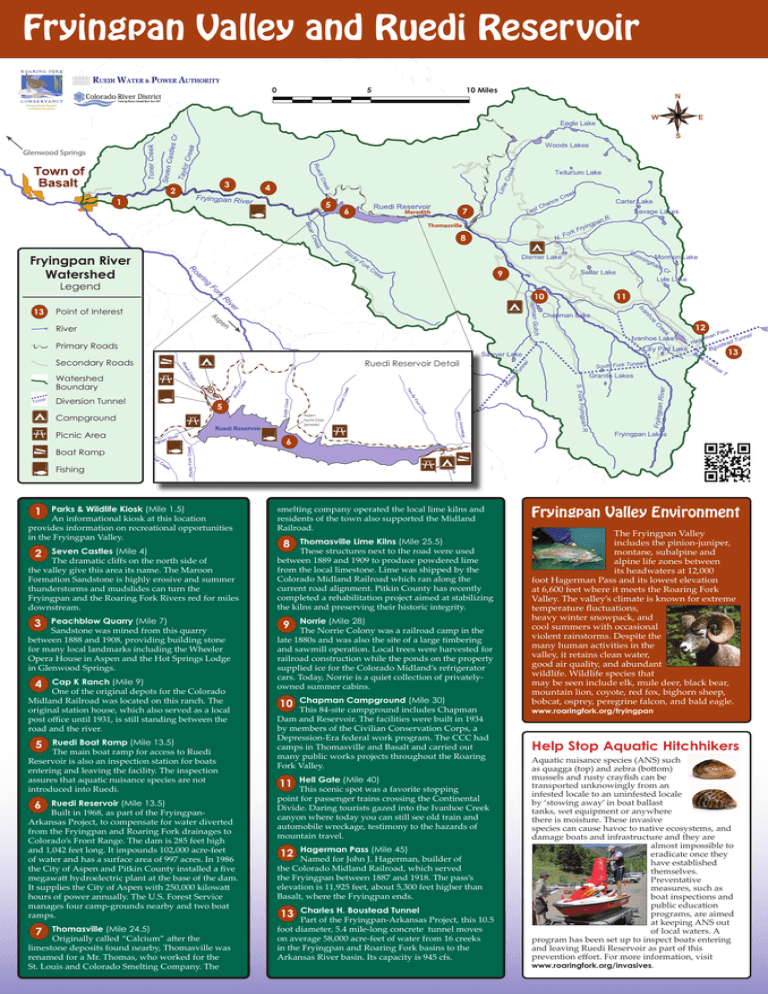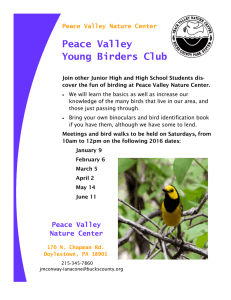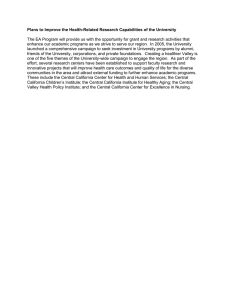Fryingpan Valley Visitor`s Guide
advertisement

Fryingpan Valley and Ruedi Reservoir 0 5 10 Miles Glenwood Springs 1 3 2 4 5 6 7 Meredith Thomasville 8 Fryingpan River Watershed 9 Legend 13 Point of Interest River Primary Roads Secondary Roads 10 11 As p en 12 13 Ruedi Reservoir Detail Watershed Boundary Diversion Tunnel 5 Campground Picnic Area Boat Ramp Aspen Yacht Club (private) 6 Fishing Parks & Wildlife Kiosk (Mile 1.5) An informational kiosk at this location provides information on recreational opportunities in the Fryingpan Valley. 1 Seven Castles (Mile 4) The dramatic cliffs on the north side of the valley give this area its name. The Maroon Formation Sandstone is highly erosive and summer thunderstorms and mudslides can turn the Fryingpan and the Roaring Fork Rivers red for miles downstream. 2 Peachblow Quarry (Mile 7) Sandstone was mined from this quarry between 1888 and 1908, providing building stone for many local landmarks including the Wheeler Opera House in Aspen and the Hot Springs Lodge in Glenwood Springs. 3 Cap K Ranch (Mile 9) One of the original depots for the Colorado Midland Railroad was located on this ranch. The original station house, which also served as a local post office until 1931, is still standing between the road and the river. 4 Ruedi Boat Ramp (Mile 13.5) The main boat ramp for access to Ruedi Reservoir is also an inspection station for boats entering and leaving the facility. The inspection assures that aquatic nuisance species are not introduced into Ruedi. 5 Ruedi Reservoir (Mile 13.5) Built in 1968, as part of the FryingpanArkansas Project, to compensate for water diverted from the Fryingpan and Roaring Fork drainages to Colorado’s Front Range. The dam is 285 feet high and 1,042 feet long. It impounds 102,000 acre-feet of water and has a surface area of 997 acres. In 1986 the City of Aspen and Pitkin County installed a five megawatt hydroelectric plant at the base of the dam. It supplies the City of Aspen with 250,000 kilowatt hours of power annually. The U.S. Forest Service manages four camp-grounds nearby and two boat ramps. 6 Thomasville (Mile 24.5) Originally called “Calcium” after the limestone deposits found nearby, Thomasville was renamed for a Mr. Thomas, who worked for the St. Louis and Colorado Smelting Company. The 7 smelting company operated the local lime kilns and residents of the town also supported the Midland Railroad. Thomasville Lime Kilns (Mile 25.5) These structures next to the road were used between 1889 and 1909 to produce powdered lime from the local limestone. Lime was shipped by the Colorado Midland Railroad which ran along the current road alignment. Pitkin County has recently completed a rehabilitation project aimed at stabilizing the kilns and preserving their historic integrity. 8 Norrie (Mile 28) The Norrie Colony was a railroad camp in the late 1880s and was also the site of a large timbering and sawmill operation. Local trees were harvested for railroad construction while the ponds on the property supplied ice for the Colorado Midland’s refrigerator cars. Today, Norrie is a quiet collection of privatelyowned summer cabins. 9 Chapman Campground (Mile 30) This 84-site campground includes Chapman Dam and Reservoir. The facilities were built in 1934 by members of the Civilian Conservation Corps, a Depression-Era federal work program. The CCC had camps in Thomasville and Basalt and carried out many public works projects throughout the Roaring Fork Valley. 10 Hell Gate (Mile 40) This scenic spot was a favorite stopping point for passenger trains crossing the Continental Divide. Daring tourists gazed into the Ivanhoe Creek canyon where today you can still see old train and automobile wreckage, testimony to the hazards of mountain travel. 11 Hagerman Pass (Mile 45) Named for John J. Hagerman, builder of the Colorado Midland Railroad, which served the Fryingpan between 1887 and 1918. The pass’s elevation is 11,925 feet, about 5,300 feet higher than Basalt, where the Fryingpan ends. 12 Charles H. Boustead Tunnel Part of the Fryingpan-Arkansas Project, this 10.5 foot diameter, 5.4 mile-long concrete tunnel moves on average 58,000 acre-feet of water from 16 creeks in the Fryingpan and Roaring Fork basins to the Arkansas River basin. Its capacity is 945 cfs. 13 Fryingpan Valley Environment The Fryingpan Valley includes the pinion-juniper, montane, subalpine and alpine life zones between its headwaters at 12,000 foot Hagerman Pass and its lowest elevation at 6,600 feet where it meets the Roaring Fork Valley. The valley’s climate is known for extreme temperature fluctuations, heavy winter snowpack, and cool summers with occasional violent rainstorms. Despite the many human activities in the valley, it retains clean water, good air quality, and abundant wildlife. Wildlife species that may be seen include elk, mule deer, black bear, mountain lion, coyote, red fox, bighorn sheep, bobcat, osprey, peregrine falcon, and bald eagle. www.roaringfork.org/fryingpan Help Stop Aquatic Hitchhikers Aquatic nuisance species (ANS) such as quagga (top) and zebra (bottom) mussels and rusty crayfish can be transported unknowingly from an infested locale to an uninfested locale by ‘stowing away’ in boat ballast tanks, wet equipment or anywhere there is moisture. These invasive species can cause havoc to native ecosystems, and damage boats and infrastructure and they are almost impossible to eradicate once they have established themselves. Preventative measures, such as boat inspections and public education programs, are aimed at keeping ANS out of local waters. A program has been set up to inspect boats entering and leaving Ruedi Reservoir as part of this prevention effort. For more information, visit www.roaringfork.org/invasives. Fryingpan Valley Then and Now Downtown Basalt as a railroad town circa 1918 (above) and today. Note train station in center of top photo. Colorado Midland Railroad (above) and the Fryingpan River Road today. In the 130­­years since settlement, the Fryingpan Valley has seen many changes, but in many ways it remains the same. The Midland Railroad is long gone, replaced by the Fryingpan Road that winds from Basalt to Hagerman Pass. The old Ruedi homestead is now the site of 1,000 acre Ruedi Reservoir and the many recreational sites that dot its shores. Even so, in many places it is easy to imagine how this valley appeared to its early inhabitants, and to appreciate its value to today’s residents and visitors. Ruedi in the early 1900s (above) contrasted by Ruedi Reservoir today. The Fryingpan River The origin of the “Fryingpan” name is uncertain, but the most colorful story is that of a group of prospectors who fled the upper part of the drainage in fear of one group of hostile Utes only to run into another encampment, whereupon one prospector remarked that they had come “out of the frying pan and into the fire.” The valley has been the home of Native American hunting parties, miners, railroaders, ranchers and recreationists since it was first explored in 1880. The river is renowned as a Gold Medal trout fishery. Please check fishing regulations and land ownership before you fish. River levels below the dam can vary due to Bureau of Reclamation release schedules, so anglers are urged to consult local fishing shops and guides for current conditions. Photo Credits: Mark Fuller, Robin Henry, Danny Hundert, Roaring Fork Conservancy, Mariah Shipp, Todd Patrick, Kelly Wood, Denver Public Library Map: Colorado River District Design: Tim O’Keefe, Roaring Fork Conservancy Supported by: Ruedi Water & Power Authority, Colorado Parks & Wildlife, and Roaring Fork Conservancy (970) 963-6622 • www.fs.fed.us White River National Forest www.rwapa.org Ruedi Water & ­­Power Authority (970) 927-1290 • www.roaringfork.org Roaring Fork Conservancy (970) 947-2920 • www.wildlife.state.co.us Colorado Parks & Wildlife (970) 927-4031 • www.basaltchamber.com Basalt Chamber of Commerce Resources The Fryingpan Valley’s unique mix of scenic beauty, historic interest, and recreational opportunity attracts thousands of visitors every year to enjoy this accessible but unspoiled area. This Visitor’s Guide will help you get the most from your time in the Fryingpan and will also provide some historic and environmental perspective. Enjoy the Fryingpan Valley and Ruedi Reservoir, and come back soon! Visitor’s Guide Welcome to the Fryingpan Valley Fryingpan Valley & Ruedi Reservoir




